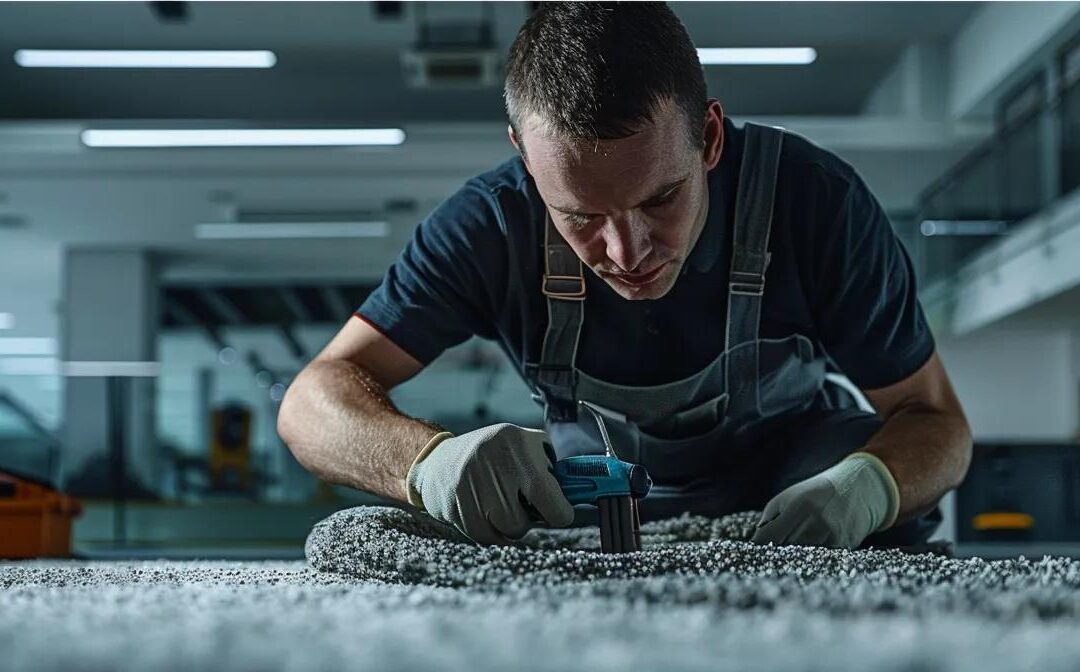carpet stretching is a vital maintenance process that addresses issues such as wrinkles, bulges, and loose seams. Over time, wear and tear, shifting furniture, and environmental changes can cause the carpet to sag, buckle, and develop unsightly wrinkles that impact both appearance and safety. This guide explains the carpet stretching process, the tools and materials used, when to seek professional help, and the benefits of professional services. It helps you decide whether carpet stretching is the right solution compared to full carpet replacement.
In many cases, carpet problems indicate underlying installation or structural issues. Wrinkles and bulges may develop when the carpet is not properly secured to the tack strips, creating safety hazards. Professional carpet stretching services use specialized techniques and tools such as power stretchers and knee kickers that not only smooth out the surface but also extend the carpet’s life. This repair is especially beneficial in high-traffic areas where a tight, even surface improves safety and appearance. Readers will gain insight into the process, the materials involved, and how to find reliable service providers near them.
What Is Carpet Stretching and How Does It Fix Wrinkles and Bulges?
Carpet stretching re-tensions the carpet to eliminate wrinkles and bulges. The carpet is pulled tight over the floor using specialized tools, ensuring it is securely attached with proper alignment and tension.
How Does the Carpet Stretching Process Work Step-by-Step?
The process involves clear, sequential steps:
- Inspection and Preparation: A technician inspects the carpet to identify areas with wrinkles, bulges, or loose seams. The area is cleaned and furniture removed to avoid damage.
- Tool Setup: Tools like the power stretcher and knee kicker are arranged. These tools provide the leverage needed to pull the carpet tight.
- Initial Stretching: Beginning at one corner, the technician uses the knee kicker to gently pull the carpet toward the wall, identifying slack areas.
- Final Tensioning: A power stretcher makes several passes across the room to create uniform tension, especially in larger spaces or where more force is needed.
- Securing the Carpet: After stretching, the carpet is re-secured along the edges using new or existing tack strips.
- Post-Stretch Inspection: The technician reviews the work to ensure all wrinkles and bulges are removed, leaving a smooth, even surface.
This careful step-by-step method not only improves the carpet’s look but also reduces tripping hazards.
Which Tools and Materials Are Used in Carpet Stretching?
Professional carpet stretching relies on specialized tools and materials: – Power Stretcher: The main tool providing the force needed to pull the carpet tight, featuring a long handle and hydraulic mechanism. – Knee Kicker: A smaller tool used in tight areas and along edges to initially align the carpet. – Tack Strips and Staples: These secure the carpet edges firmly to the floor. – Protective Underlay (if needed): A thin padding may be added for better adhesion. – Adhesives and Fasteners: High-quality adhesives secure seams and provide extra hold.
Using the proper tools and materials ensures a secure, long-lasting repair and reduces future wear and tear.
What Types of Carpets Can Be Stretched?
Most types of carpets benefit from stretching: – Berber Carpets: Looped pile carpets prone to visible wrinkles. – Plush Carpets: Dense, luxurious types that can develop bulges. – Textured Carpets: Carpets with varied pile heights that may show irregularities. – Commercial Carpets: High-traffic areas benefit from regular stretching to maintain appearance and function.
Even older carpets in good overall condition can often be stretched. However, extensively damaged carpets (e.g., burns or severe mold) may need repair or replacement instead.
When Should You Consider Professional Carpet Stretching?
Consider professional stretching when: – Visible Wrinkles and Bulges Appear: They are both an aesthetic and safety concern. – Increased Tripping Hazard: Uneven surfaces may lead to accidents. – Frequent Furniture Movement: Rearrangement often loosens the carpet. – Aged Carpet: Over time, carpets lose their initial tight installation. – Recurring Problems: If past stretching attempts have failed, professional assessment can help.
Professional services offer the expertise and warranties that guarantee a lasting solution without the need for full replacement.
What Are the Benefits of Professional Carpet Stretching?
Beyond cosmetic improvements, professional carpet stretching addresses structural issues, enhances safety, and saves money over time.
How Does Carpet Stretching Extend Carpet Lifespan?
Stretching re-establishes the carpet’s original tension. When the carpet is loose, the fibers wear out faster and the backing can deteriorate. By restoring tension: – Uniform Tension is Restored: Reducing friction from foot traffic. – Prevents Delamination: Keeping carpet layers bonded. – Enhances Structural Integrity: A smooth, tight carpet resists further wrinkling.
A properly stretched carpet remains functional and attractive for a longer period, providing a better return on your investment.
What Improvements in Appearance and Safety Can You Expect?
Professional stretching offers noticeable improvements: – Aesthetic Enhancement: A smooth carpet revitalizes the room’s look and transforms its ambiance. – Reduced Tripping Hazards: Eliminating wrinkles helps prevent trips and falls, especially important in homes with children or seniors. – Overall Neatness: A well-stretched carpet gives a polished, maintained appearance, enhancing the home’s value.
Customers often observe a significant boost in the room’s overall feel and functionality following a professional service.
How Does Carpet Stretching Save Money Compared to Replacement?
Carpet stretching is a cost-effective alternative to complete replacement: – Lower Direct Costs: It is far less expensive than purchasing and installing new carpet. – Avoiding Replacement Hassles: Restoring your carpet minimizes disruption and additional costs. – Prolonged Carpet Life: Extends the life of your current carpet, delaying the need for replacement. – Warranty and Satisfaction: Many professionals back their work with warranties, adding peace of mind.
Thus, carpet stretching is an investment that restores appearance and function at a much lower cost than full replacement.
What Warranty and Satisfaction Guarantees Are Typically Offered?
Reputable companies often provide guarantees such as: – Workmanship Guarantees: Covering the recurrence of wrinkles or bulges within a set period. – Satisfaction Guarantees: Promising to redo work if the results are unsatisfactory. – Extended Warranties: Some providers offer longer-term coverage, reflecting their confidence in their work. – Written Agreements: Clear contracts outlining warranty terms for transparency and accountability.
These guarantees reinforce the commitment to quality and customer satisfaction.
What Are Common Carpet Problems That Carpet Stretching Can Fix?
Carpet stretching effectively addresses several common issues, preventing further deterioration and higher repair costs.
How Are Carpet Wrinkles and Buckles Caused?
Common causes include: – Improper Installation: Initial stretching errors can lead to wrinkles over time. – Daily Foot Traffic: Regular use and moving furniture loosen the carpet. – Environmental Changes: Temperature and humidity fluctuations can cause the carpet to expand and contract. – Subfloor Irregularities: An uneven subfloor might contribute to unwanted folds.
Recognizing these causes helps professionals not only fix the current issues but also offer advice to prevent future problems.
Can Carpet Stretching Repair Loose Seams and Bubbles?
Yes, stretching often repairs issues like loose seams and bubbles: – Seams Are Realigned: Pulling the carpet forces panels to reconnect. – Underlying Bubbles Are Smoothed Out: Consistent tension reduces unsightly puckering. – Supplemental Adhesives: In some cases, adhesives secure the seams after stretching.
This method improves the overall appearance without extensive repairs.
When Is Carpet Stretching Not Enough and Repair Is Needed?
While effective for many issues, stretching may not suffice when: – Severe Damage: Deep burns, stains, or rips require patching or full replacement. – Structural Issues: A warped or damaged subfloor may need additional repair. – Excessive Wear: Very worn carpets might benefit from a complete overhaul. – Inadequate Adhesion: Degraded carpet backing sometimes requires more than stretching to secure.
A thorough professional assessment is necessary to decide on the best course of action.
How Does Professional Assessment Determine the Best Solution?
A technician will examine: – Degree of Tension Loss: Measuring slack to decide if stretching will restore tension. – Visible Damage: Noting burns, tears, and worn areas. – Subfloor Condition: Assessing whether the subfloor requires repair. – Repair History: Previous stretching issues may indicate a need for alternative methods.
Based on this evaluation, professionals recommend stretching, patch repairs, or replacement for the most cost-effective and lasting result.
Where Can You Find Reliable Carpet Stretching Services Near You?
Locating a reputable local service requires careful research and understanding of what to expect from professionals.
How to Choose the Best Local Carpet Stretching Company?
Key factors to consider include: – Experience and Reputation: Look for a long history and positive reviews; ask for references or examples of similar projects. – Certifications and Training: Ensure technicians are certified and professionally trained. – Transparency in Pricing: The provider should offer clear, upfront pricing including any extras. – Insurance and Warranty: Verify liability insurance and warranty coverage. – Customer Service: Responsive communication during consultations is a positive sign.
These factors help narrow your choices to companies committed to quality and transparency.
What Are the Benefits of on-Site Carpet Stretching Services?
On-site services offer significant advantages: – Convenience: Technicians work at your location, avoiding the hassle of moving large or delicate items. – Immediate Assessment: Being on-site allows for a complete evaluation of both the carpet and the subfloor. – Customized Solutions: Technicians tailor their approach to your specific conditions. – Reduced Downtime: Repairs can often be completed with minimal disruption to your routine. – Cost Savings: On-site evaluations can uncover hidden issues early, reducing future repair costs.
This personalized service ensures an effective solution that improves your living environment.
How Does Service Area Coverage Affect Availability?
Consider these aspects when selecting a provider: – Local Expertise: Companies familiar with local flooring styles and common issues offer more tailored solutions. – Response Time: Proximity allows for quicker scheduling and emergency repairs. – Regional Warranties: Local providers often offer warranties designed for the specific climate and regional conditions. – Customer Reviews: Local feedback can be verified more easily. – Logistical Efficiency: Shorter travel times can reduce costs and improve scheduling flexibility.
Understanding a company’s service area helps ensure you get reliable and prompt service.
What Do Customers Say About Local Carpet Stretching Providers?
Customer feedback provides valuable insights: – Consistent Quality: Many customers highlight consistent, high-quality work. – Professionalism: Reviews often mention courteous, punctual service and clear explanations. – Reliability: Satisfied customers typically become repeat clients and offer word-of-mouth recommendations. – Value for Money: Many note that stretching is far less expensive than complete carpet replacement. – Post-Service Support: Timely follow-ups and solid warranty support reinforce customer trust.
These testimonials underscore the benefits of engaging with reputable local providers.
Frequently Asked Questions
Q: What exactly does carpet stretching involve?
A: Carpet stretching uses professional tools to pull the carpet tight, eliminating wrinkles and bulges. This process realigns loose seams and improves the flooring’s appearance and safety while extending its lifespan.
Q: How long does the carpet stretching process take?
A: Typically, the process takes a few hours—most professionals finish within 2 to 4 hours, depending on the room size and the carpet’s condition.
Q: Can carpet stretching fix all carpet problems?
A: It effectively fixes wrinkles, bulges, and loose seams. However, severe damage such as burns, deep stains, or extensive deterioration may require additional repairs or even replacement.
Q: Is professional carpet stretching worth the cost?
A: Yes. It is a cost-effective alternative to carpet replacement. By restoring the carpet’s appearance and safety and reducing further damage, stretching often delays the need for an expensive overhaul.
Q: How often should I have my carpet stretched professionally?
A: Generally, every 5 to 10 years or sooner if you notice visible wrinkles or bulges can help prevent minor issues from becoming serious problems.
Q: What maintenance tips can prevent carpet wrinkles from recurring?
A: Regular cleaning, prompt spot treatment of spills, and careful furniture rearrangement help. Periodic professional re-stretching also maintains proper tension.
Q: Are there any risks associated with carpet stretching?
A: When done by experienced professionals, it is safe. Incorrect use of equipment or inexperienced technicians can cause damage. Always verify credentials and check customer reviews before hiring.
Final Thoughts
Professional carpet stretching is an effective repair solution for wrinkles, bulges, and loose seams. It extends your carpet’s lifespan, enhances safety, and is a cost-effective alternative to replacement. With tailored on-site services, transparent pricing, and solid warranty guarantees, homeowners can trust that their investment is protected. A thorough understanding of when and how to use this service enables long-term solutions that maintain both aesthetic appeal and functional safety in your living space.







